
DS 3 Review

Introduction
The new DS 3 is nothing like the original DS 3. That car was a small hatchback to rival the Mini Hatch, but this is really a replacement for the old DS 3 Crossback, a compact SUV that took the battle to the Lexus UX and the Audi Q2 in the premium sector. Its success was, with the best will in the world, limited, so DS has fitted a few updates to the styling and the on-board technology to try and keep pace with the best on the market.
(You can read our news update on the DS 3 here)
In an attempt to give the DS 3 even more of a fighting chance, the company has also set about making changes to the engine range. Removing diesel power from the line-up altogether would normally be the headline alteration, were it not for the fact the French manufacturer has tweaked the electric ‘E-Tense’ model to give it more power and more range. But will that be enough to fend off other appealing compact premium models?
Select's rating score* - 3.0 / 5
At a Glance
When you first set eyes on the DS 3, it doesn’t necessarily look as though much has changed, until you spot the modified grille and the new lights, as well as the slightly tweaked rear end. That means the car looks much the same as before, albeit with a slightly fresher face and some even more premium pretensions.
A similar policy has been adopted inside, where the car still gets the same dashboard design with premium trim and posh seats, but there’s now a new touchscreen that dominates proceedings. That comes with slightly sharper graphics and improved functionality, as well as a cleaner and more glossy look, although DS hasn’t fixed issues with the material quality on the doors and lower down on the dash.
What DS has fixed is the E-Tense electric powertrain, giving it an extra 20hp and upping the battery capacity to 54kWh. At the same time, the system has become more efficient, giving the car a much more competitive range on a single charge. Even alongside the strong 1.2-litre petrol engine, the E-Tense looks much more compelling than ever before.
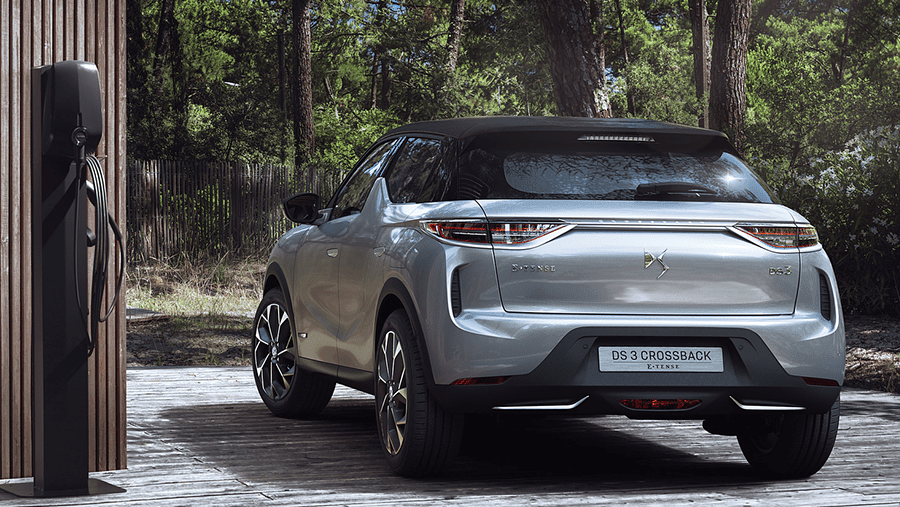
Key Features
For many, the key to the DS 3’s appeal will be its design, and while it has tried to capture some of the features that made the original DS 3 (by which we mean the three-door hatchback) such a hit, we don’t think it’s quite as easy on the eye. Nevertheless, it’s distinctive and different, and it has managed to do that without ever being ugly.
And for those who choose the E-Tense electric model, the new DS 3’s bigger battery and more powerful motor will be a massive improvement. Somehow, despite endowing the car with an extra 20hp and less than 10% more battery capacity, range has shot up by 20%. Of course, official figures don’t mean much in the real world, but our test suggested a charge should allow drivers to cover more than 200 miles relatively easily, as long as you don’t use the motorway much. That’s a very useful range for a compact cars. You can find out more about EV range in out electric car range guide.
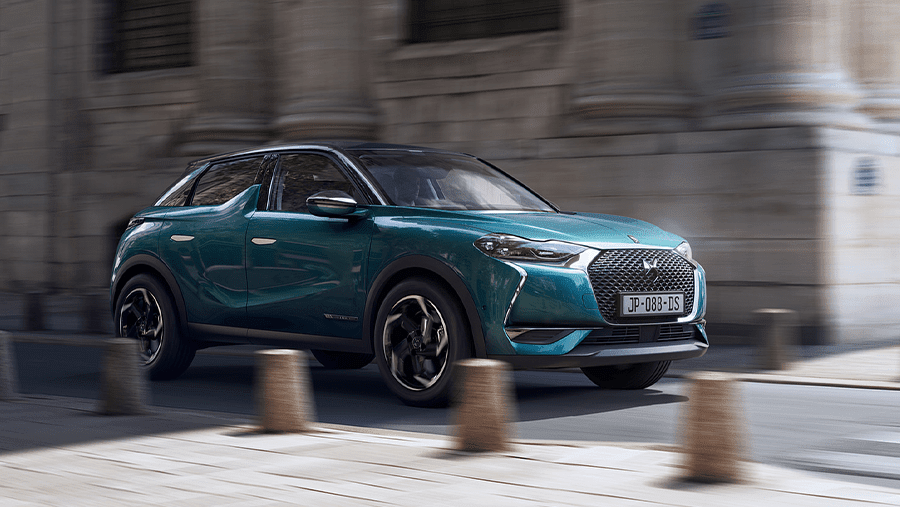
Range & Batteries
Whereas the old DS 3 Crossback E-Tense came with a 50kWh battery and a 100kW motor, electric versions of the new DS 3 get a 54kWh battery that powers a 115kW electric motor. Despite the extra power and the relatively small increase in capacity, the range has increased by around 25%, giving the new car a range of up to 250 miles on the official economy test. And our test drive suggested customers might get somewhere near that figure, as long as they don’t spend too much time on the motorway.
Need to be sure that your EV goes the distance? We've got a guide to run you through official v. real-world battery range.
Performance & Drive
DS 3 customers face a simple choice between petrol and electric powertrains. Those who opt for the former get a very accomplished 1.2-litre turbocharged petrol engine that produces either 100 or 130hp, depending on which version you pick. As the 100hp option is only available with the cheapest version of the DS 3, most will get the 130hp option, complete with its eight-speed automatic gearbox.
The combination is tried and tested, and it serves well enough in the Vauxhall Astra, Peugeot 308 and even the Citroen C5 Aircross. In the DS 3 it feels perfectly punchy enough and it offers ample performance, with a 0-62mph time of less than 10 seconds. It’s relatively frugal, too, sipping its way through a gallon of unleaded every 40-odd miles.
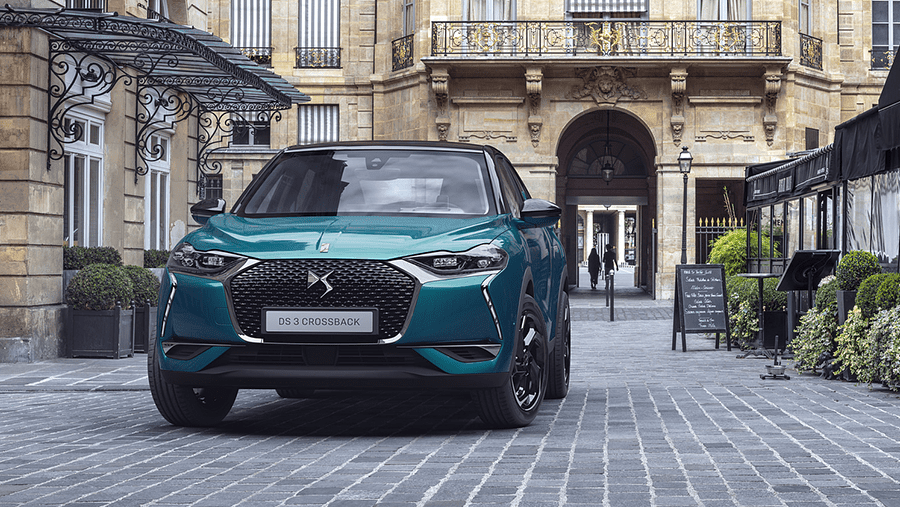
But arguably the most appealing, and certainly the most headline-grabbing of all the DS 3s variants is the new E-Tense, with its bigger battery and more powerful motor. Now with 156hp – an increase of 20hp compared with the DS 3 Crossback E-Tense – it isn’t much faster than its predecessor on paper, but it has a little more mid-range punch, and that’s what matters on the road.
The petrol and electric DS 3s are separated by more than just their powertrains, though. The two cars drive very differently, to such an extent that they could be completely different cars altogether. Where the petrol car feels light and nimble, the E-Tense feels heavier, but more stable as a result. And the electric versions ride considerably more comfortably than the petrol-powered alternatives, which jiggle about a bit on uneven surfaces.

In contrast, the E-Tense feels smooth and unruffled, even at speed. There’s only a hint of wind noise and the motor makes almost no noise at all, while road noise is kept to an absolute minimum. As a result, it feels more premium than the petrol-powered DS 3s, but then it is a considerably more expensive car.

Charging
Charging at home will invariably prove the cheapest option for most customers, but it isn’t necessarily the fastest. DS doesn’t publish a charge time for 13-amp, three-pin domestic sockets, but the general advice is not to try. Instead, the company recommends getting a ‘wallbox’ charging unit that can charge more rapidly, at up to 7.4kW for most homes. Use that, and the charging time falls to seven-and-a-half hours, which means charging overnight should be perfectly feasible.
However, when you’re on the move, you can charge even more rapidly. Using a 100kW rapid charger, the DS 3 takes just 30 minutes to get from empty to 80% full, and that’s pretty good going, especially now the car has its enlarged battery. Be sure to consult our guide to picking your ideal electric car charger to find out more.

Running Costs & Emissions
Unsurprisingly, the E-Tense will likely be the cheapest DS 3 to run, as long as you can charge at home or on a public charger with a membership. And it isn’t just the fuel/electricity costs that should be taken into account. For company car drivers, the E-Tense will also be significantly cheaper to tax, with electric cars attracting Benefit in Kind (BIK) of just 2% until the 2024/25 financial year.
But no DS 3 is likely to be especially ruinous, no matter which version you choose. Even the most powerful petrol examples are reasonably frugal and the emissions aren’t too hideous. That said, the high purchase price of the high-specification examples might mean company road tax looks a bit expensive compared with some rivals.
Interior & Technology
DS hasn’t done a huge amount to the 3’s cabin, but perhaps the key change is the new touchscreen infotainment system. No matter which trim level you choose, you get the same massive screen with a glossy finish, providing a sharper and more modern graphics and functionality than before. The screen still isn’t perfect – some of the buttons are a bit fiddly and there’s still a bit of lag here and there – but it’s a vast improvement on what went before.
Alongside that, DS has also fitted a digital instrument cluster that’s sharp and presents all the information you really need, but although there’s a big bank of buttons on the dash, you might notice there are no heater controls. Instead, they’ve been integrated into the touchscreen, which is a mixed blessing. While we aren’t a great fan of touchscreen climate control, the new screen makes the system more responsive and intuitive than before, albeit not by very much.
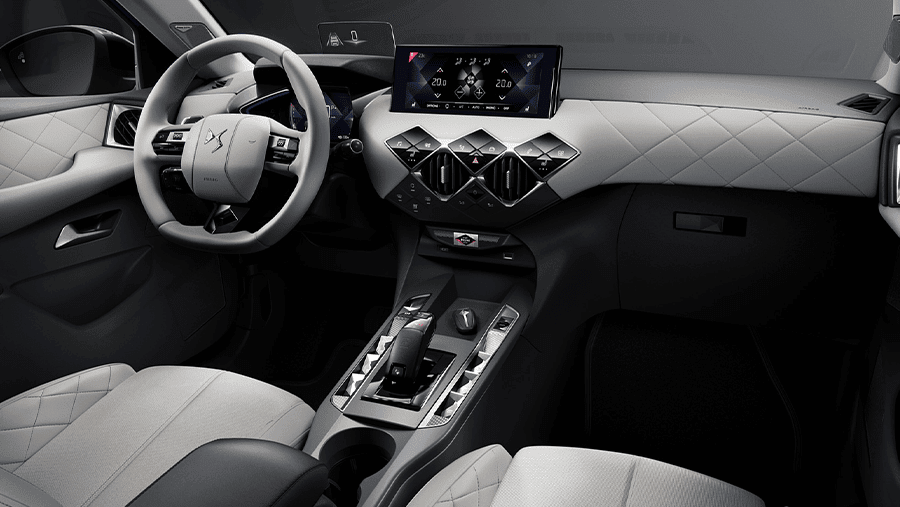
But while technology is a key part of the premium car experience, so too is quality. And that, traditionally, is where DS has struggled. In the DS 3, there are plenty of neat touches, including the leather-trimmed dash and the sculpted seats, but even that can’t hide the cost-cutting measures so often found in small cars. In fact, if anything, it highlights the cheap feel of the plastics around the glovebox and on the doors.
Ergonomic issues are numerous, too, including the rack of buttons either side of the gear selector. In case you were wondering, these are the window switches for all four doors, except, of course, for the buttons that aren’t window switches at all. There’s a tiny pictogram to show you which is which, but they aren’t that easy to see and it’s easy to get muddled up. Why those switches couldn’t go on the door is beyond us.
Naturally, customers will likely get used to these foibles over time, but we think the driving position might take a little more adjustment. Although the steering wheel is adjustable for reach and rake, the driving position still seems to be designed for people with very long arms and very short legs, which essentially means it takes a while longer to get comfortable behind the wheel. It’s fine for a short drive, but it might get a bit uncomfortable over long distances.
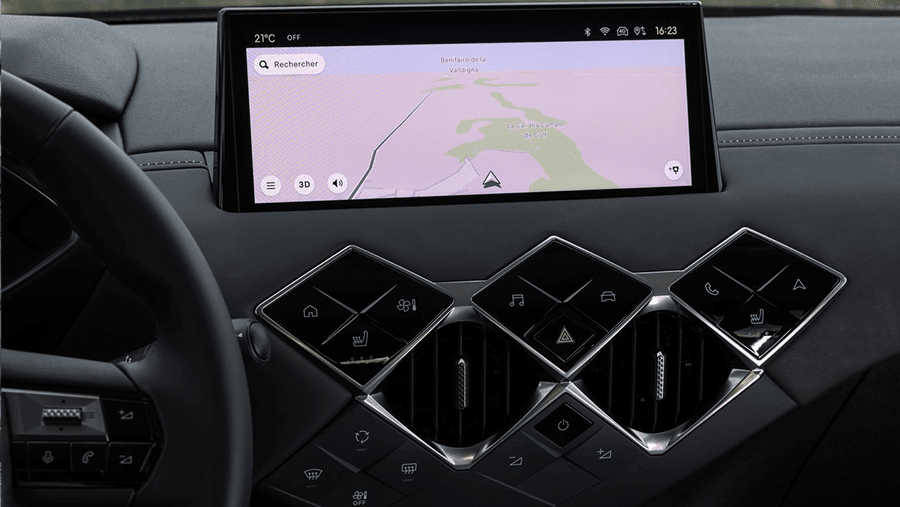
Practicality & Boot Space
The DS 3 is quite a compact thing, and that means it isn’t the most spacious car in the world. At just 4.1 metres in length, it’s just a few centimetres longer than a VW Polo, and the effect on interior space is predictable.
That said, the boot measures 350 litres with the back seats up, and that’s roughly the same space you’ll get from a supermini such as a Polo or a Hyundai i20. It compares favourably with the Lexus UX, too, but the Audi Q2’s boot measures well over 400 litres, and the extra 50 or so litres of capacity makes quite a difference.
But while boot space is competitive, if not plentiful, the space in the back is less of a strong point. You can fit adults in there, but those over six feet tall won’t want to spend very long cooped up in there – especially if you choose the Performance Line models with their black roof lining. Kids should be fine in the back, though, so the DS 3 might work for young families, single people or couples.

Safety
Because the new DS 3 is essentially just a revamped DS 3 Crossback, it has not yet been tested by Euro NCAP, and we don’t expect the organisation to do so. That said, it will effectively inherit the Crossback’s safety rating, and that’s good news, because the Crossback performed admirably when it was tested in 2019. A five-star rating included an impressive 96% score for adult occupant protection and a solid 86% for child occupant protection.
Of course, the test has moved on since then and the Crossback might not score as highly in the new test, which puts more emphasis on safety equipment that prevents accidents from happening in the first place. That said, the basics remain more or less the same, so the new DS 3 should be a very safe car.
And, to please the regulators and drivers alike, it still comes with plenty of driver assistance tech, including autonomous emergency braking that can slow the car down or even stop when it detects a hazard to which the driver has not responded. Lane departure warning and speed limit recognition are also standard, along with rear parking sensors and cruise control.
But high-spec DS 3s also get some extra equipment, such as a more advanced autonomous emergency braking system that can pick out pedestrians and cyclists, and blind-spot monitoring, which flags up any cars that have wandered into the blind spots over the driver’s shoulders.

Options
DS 3 customers get four trim levels to choose from, with Performance Line representing the entry-level option. That car comes with sportier styling than some of the more upmarket models, with black wheels, black exterior trim and black roof lining, as well as Performance Line badging and suede trim on the dash. Standard equipment also includes push-button ignition and rear parking sensors, not to mention climate control, automatic LED headlights and cruise control.
Customers can move up to the Peformance Line + if they so wish, getting darker tinted rear windows as part of the deal, along with connected car technology and keyless entry. You also get similar levels of standard equipment from the mid-range Rivoli, but that car focuses on style and luxury rather than sportiness. That means you get chrome trim around the grille and door handles, and there’s leather on the dashboard.

Finally, the range is topped off by the Opera model, which gets pretty much every toy you can think of. Posh seats, wireless phone charging, and advanced safety systems are all on the menu, along with a reversing camera and front parking sensors.
DS is also offering a range of options, with a head-up display and an upmarket Focal hi-fi system all in the offing. And, of course, there’s the usual array of wheel designs and colours, including the smart Riva Red, and a choice of two contrast roof colours: Perla Nera Black and Carat Grey. There’s a selection of optional interior finishes, too, including the attractive, but perhaps not especially practical, Pebble Grey Cloth.

Rival Cars
The DS 3 doesn’t have that many direct rivals, thanks to its compact size and SUV attitude. Premium cars tend to be a little larger and more spacious, or they will generally sit a little lower to the ground. Nevertheless, there’s plenty of crossover with other models on the market, with the closest alternative being the Lexus UX (below). That compact SUV is also available in electric form and it’s better built than the DS, but it feels a bit dingy in there and the infotainment is problematic.

Other than that, there’s the much more practical but slightly less luxurious Volkswagen Taigo, or you could look at hatchbacks such as the five-door Mini Hatch. If you’d rather, you could also opt for the much bigger Audi Q2, which looks very different to the DS and is considerably more spacious, but the list price is much the same.
Casting the net further still brings you to cars such as the underrated Seat Arona or the surprisingly solid Renault Captur (below), but both cars feel less upmarket than the style-conscious DS.

Verdict & Next Steps
The DS 3 has improved slightly as a result of its most recent update, but it remains a niche proposition. A high price tag holds it back, especially when other premium models offer more space for less outlay, and better quality for the money. That said, the DS scores highly on style and it comes with a solid choice of powertrains, while the DS brand and the chance to drive something different will appeal to those who’ve already ruled out alternatives from more mainstream brands.
Where to next?
View our latest DS3 lease deals - from just £247.37 per month inc VAT**
Looking for a great leasing deal? Check out our incredible range of Special Offers
New luxury Hatchback? Read our latest Car Reviews and find the right model for you
Want to know more about leasing? Take a look at our comprehensive Leasing Guides
Interested in everything motoring? Why not catch up on all the latest Car Leasing News.
*Score based on Select’s unique meta score analysis, taking into account the UK’s top five leading independent car website reviews of the DS3
**Correct as of 06/02/2023. Based on 9 months initial payment, 5,000 miles over a 48 month lease. Initial payment equivalent to 9 monthly payments or £2,226.33 Ts and Cs apply. Credit is subject to status.


















